While exercising, listening to music and a podcast can help us through the toughest moments, whether completing interval sprints or extended Zone 2 sessions. However, if we stick to using even the best headphones and in-ear earphones, we lose the read of our surroundings – at best, this is a bit disorientating; at worst, it is just plain dangerous, especially if you exercise in public spaces. Here is where bone-conduction headphones come in, as they use a clever mix of physics and biology to ensure you can listen to audio while still being aware of your surroundings.
Bone conduction headphones help you maintain situational awareness by sitting outside the ear and leaving the ear canal open. Unlike normal runner headphones, audio from a Bluetooth device is played through drivers, often called transducers, specially designed to send vibrations through your cheekbones. The inner ear picks up these vibrations, and thus, you can hear the music. At the same time, because your ear canal is open, ambient sound can still reach your eardrum, meaning that if you are walking down the street listening to the latest true crime podcast, you will still be able to hear traffic and other pedestrians, allowing you to navigate the roads safely.
The best bone-conduction headphones 2025 at a glance:
This audio and open-ear safety combination is why runners and cyclists have widely adopted bone-conduction headphones. The best bone-conduction headphones allow users to stay aware of their surroundings, which is crucial when exercising in more dangerous environments, such as busy roads. For this reason, England Athletics bans traditional earphones, earbuds, and headphones but allows bone-conduction headphones.
We are avid audio and fitness fanatics at What's The Best, and many of our writers have been using bone-conduction and open-ear technology since we first reviewed it in 2021. This first-hand experience gives us insight into what does and doesn't work. We've collated our expertise into this article, highlighting the best bone-conduction headphones available in 2024.
Please note: All prices are correct at the time of writing. Prices, stock and deals are subject to change without notice.
The best bone conduction headphones in 2025
Best overall bone-conduction headphones
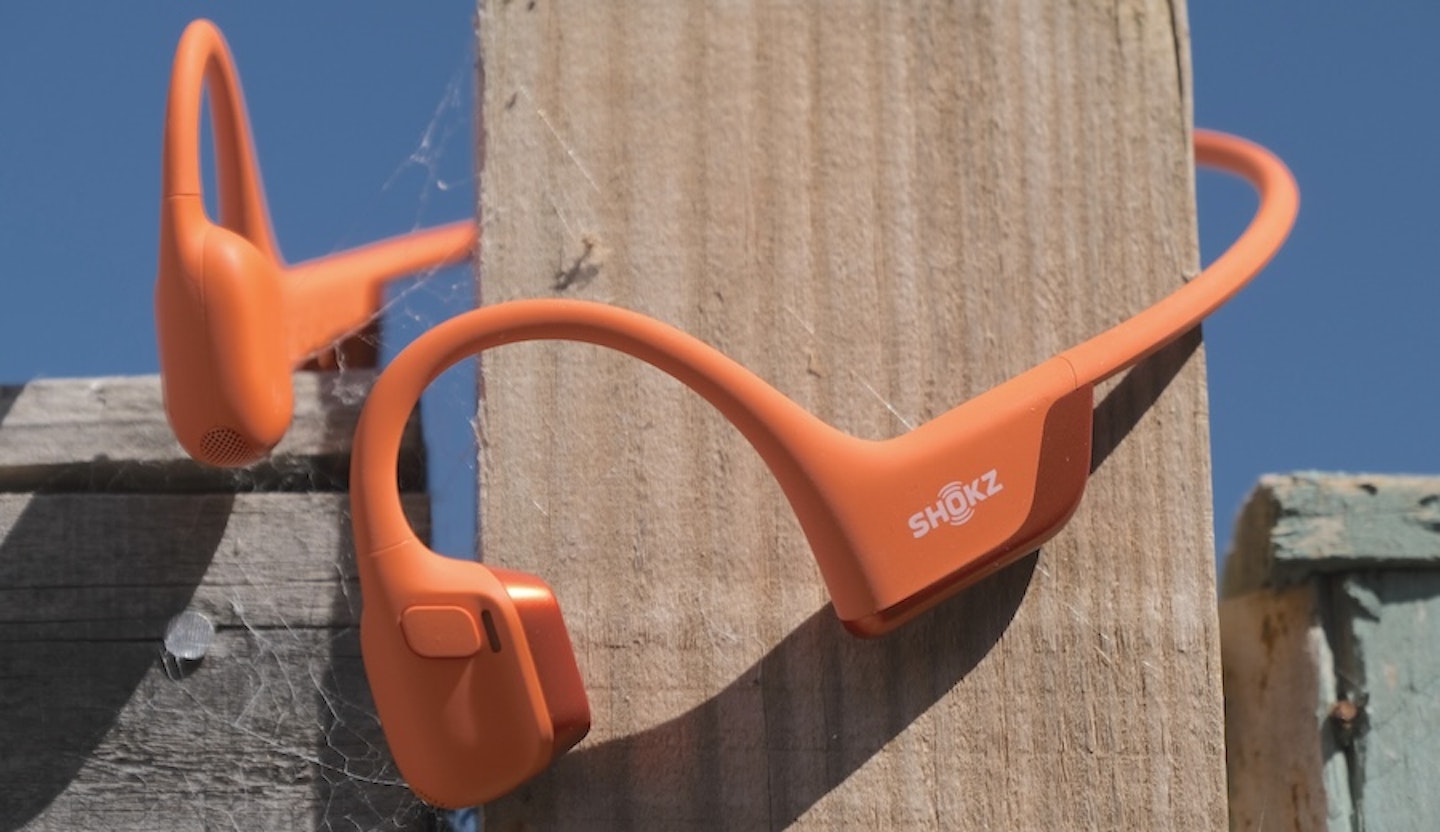 What's The Best/William Austin-Lobley
What's The Best/William Austin-Lobley Building on the success of the OpenRun Pro, the Shokz OpenRun Pro 2 takes open-ear listening to a new level while maintaining all that makes Shokz so good for runners.
Sound improvement is the most significant change here, and it's a positive one. The all-new DualPitch technology combines bone and air conduction to deliver an audio experience that's rich and full – even comparable to in-ear earphones. Whether running, cycling, or just walking around, the sound quality is impressive across all frequencies. However, the sound leak from the air-conduction tech is noticeable in quiet environments, so keep that in mind if you plan to use them in the office.
The design is comfortable and secure, even when wearing glasses or a bike helmet. The lightweight build, sweatproof design and easy-to-use controls make it comfortable to wear all day. However, the sound leak from the air-conduction tech is noticeable in quiet environments, so keep that in mind if you plan to use them in the office.
Our Digital Editor, William Austin-Lobley, had a few weeks to review the OpenRun Pro 2 before they launched. Here's what he thought:
"This type of technology has always been about compromise: you get to hear your surroundings, but the audio quality takes a hit. The OpenRun Pro 2 has plugged this gap with its combined DualPitch tech, which offers a really rich and full sound thanks to its warm bass sound. It really puts a smile on my face."
"I like a few other quality-of-life features, too. For example, the 12-hour battery life is a nice plus for those who forget to charge their gear (like me). As an IP55-rated product, it's sweat and rainproof. Also, the ability to add customisable EQ profiles in the app is a nice touch."
Pros
- The all-new DualPitch tech delivers excellent audio, in tone, volume and clarity
- 12 hours of battery life and USB-C charging
- Flawless Shokz build and comfort, whether sitting, walking, running or cycling
Cons
- Air conduction means increased sound leak, a problem in quiet areas
| Battery life | 12-hours playback, 10 weeks standby |
| Charge time | 1hr to full or 5 minutes for 2.5hr playback |
| IP rating | IP55 |
| Weight | 30g |
Best budget bone-conduction headphones
 Hanmer
Hanmer Hanmer is a little-known budget brand, but its bone-conducting headphones are worth a shout if you want to try open-ear tech out without spending much money. Although they bring nothing new to the stage, they cover the basics – waterproofing, Bluetooth, and bone-conduction tech – to a reliable standard.
The fit is secure, and the weight is only 30g, which is reasonable considering the battery runs for 10 hours, slightly better than the OpenMove. The button controls and the IP55 rating, which protects against sweat and dust, are precisely in line with the OpenMove.
However, overall, the materials used are a dip compared to others listed here. Considering the price, these are worth a go for bone-conduction newcomers.
Pros
- Reliable build quality and design
- Great 10-hour battery life
- Excellent value
Cons
- IP55 and therefore only rated for rain showers, not downpours
| Drivers: | Bone conduction technology |
| Output power: | Not specified |
| Frequency range: | Not specified |
| Connectivity: | Bluetooth 5.3 |
| Battery life: | Up to 10 hours |
| Charging time: | Two hours |
| Waterproofing: | IP55 |
| Dimensions: | Not specified |
| Weight: | 30 g |
Best budget Shokz headphones
 Shokz
Shokz The Shokz OpenMove proves that sometimes, basic is best. Though these headphones are the brand's entry-level offering, they offer everything that makes bone-conduction tech excellent at a welcome price.
On the scene since 2021, the OpenMove has provided a quality audio performance across frequencies, with only the bass falling off, as is very common with this technology (one of the compromises you must make for total situational awareness).
Functionality is kept simple, with controls to power on/off, change the volume, play/pause, and accept an incoming call. These functions are mapped to physical buttons, which is far more reliable than relying on touch controls when active.
They weigh only 29g, making them comfortable and light on the head. Their construction is solid, and they have an IP55 water and dustproof rating to protect them from rain showers, sweat, and grime. Our editor, William Austin-Lobley, has used his pair for three years without fault – since they were called AfterShokz, in fact.
Six hours of battery life will mean most will only have to charge them once a week, and anyone completing a marathon-length event will be kept motivated until they cross the line. Charging is via USB-C.
Pros
- Essentials nailed – only the basics here, but they are all without fault
- Excellent build quality – we've had ours for upwards of three years
- Physical controls – actual buttons, which are easy to use during runs
Cons
- Battery life is only six hours, which is middling
| Drivers: | 7th Generation Bone Conduction Technology |
| Output power: | Not specified |
| Frequency range: | 20Hz to 20KHz |
| Connectivity: | Bluetooth 5.1 |
| Battery life: | Up to six hours of continuous use |
| Charging time: | Approximately two hours |
| Waterproofing: | IP55 (sweat-resistant) |
| Dimensions: | 50.8 x 127 x 107.9 mm (H x W x D) |
| Weight: | 29 g |
4.
Suunto Wing
Best bone-conduction headphones for battery life
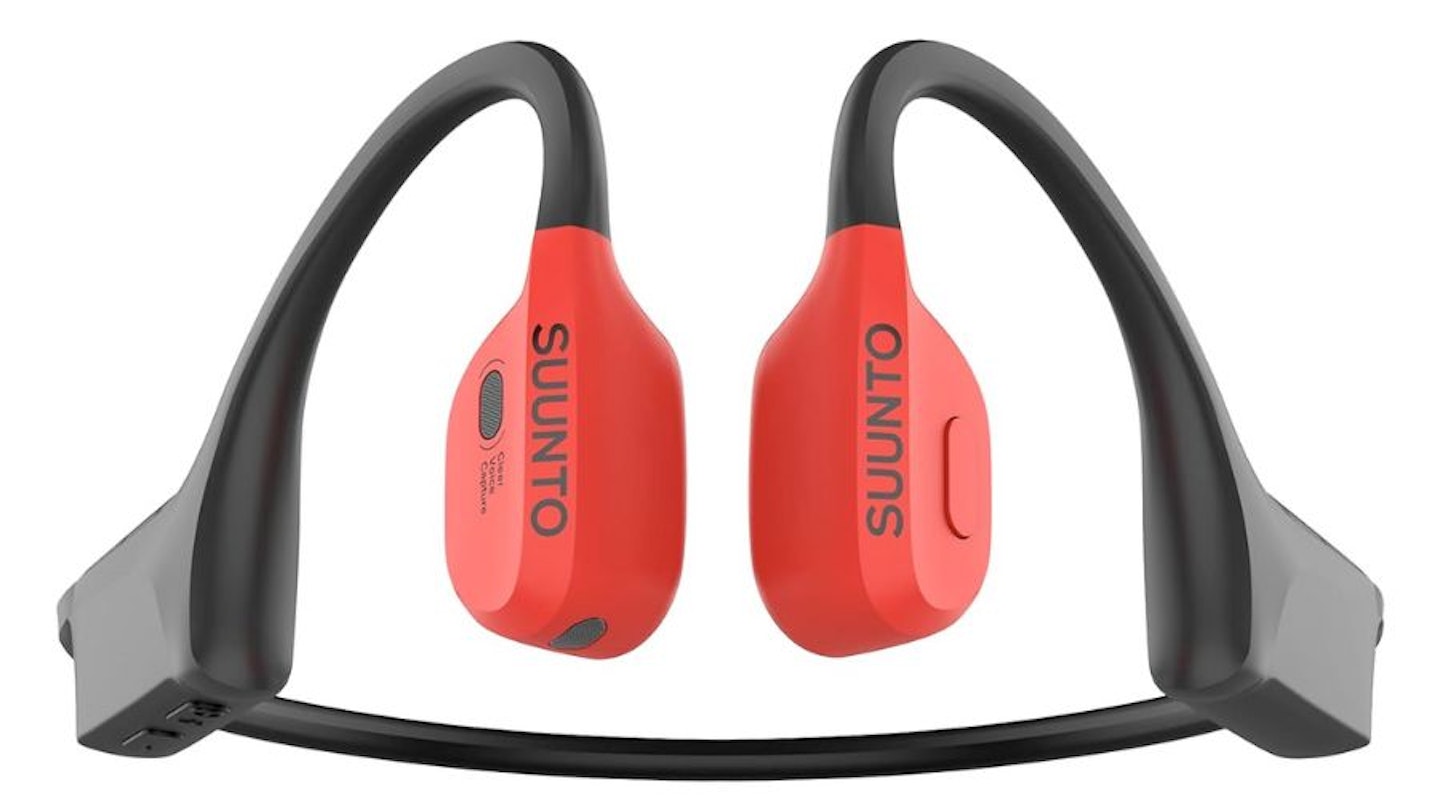
Adventure stalwarts will be very familiar with the Suunto brand. With the Suunto Wing, we see the brand's first foray into headphones. True to form, it adopted a premium approach to features (and pricing), but for that outlay, you will be treated to a few nice extras, over and above standard bone-conduction fare.
The first is its portable and pocketable charging dock, which acts like the case you will find with most wireless earbuds. It charges the Wing headphones to extend their 10-hour battery life by an additional 20 hours, a nice touch in a marketplace dominated by short battery lives. A 10-minute docking gives three hours of playback.
The second is a proprietary Head Movement Control, which allows you to use nodding or head shaking to skip songs or answer calls. A nifty trick, but those in a busy environment – and abiding by the Green Cross Code, looking left and right before they cross the road – may run into issues. But then you can always turn them off in the Sunnto app.
The sound you'll experience with the Wing headphones is the standard bone-conducting fare, though Sunnto has tried to expand the sound profile. It has two sound modes, Standard and Outdoor, which boosts volume for louder environments. The difference is small, but some may find value here.
The Suunto Wing's IP67 rating means it can withstand a downpour. It also features an LED safety light, like the Philips Audio A7607, which can be customised via the app.
Pros
- Boosted battery – 10 hours from the headphones and 20 more from the case
- Quick charging – Three hours of playback from 10-minutes of charging
- IP67 – Downpour ready for hardy runners and cyclists
Cons
- Sound modes offer little variation
- Expensive model compared to the competition
| Drivers: | Bone conduction technology |
| Output power: | Not specified |
| Frequency range: | 20Hz - 20kHz. |
| Connectivity: | Bluetooth 5.2 |
| Battery life: | Up to four hours (30 with charging case) |
| Charging time: | 15 minutes of charging time for three hours of use |
| Waterproofing: | IP67 (Waterproof, not submersible) |
| Dimensions: | 126.5 x 102.5 x 46.5 mm (H x W x D) |
| Weight: | 28 g |
Best Shokz alternative
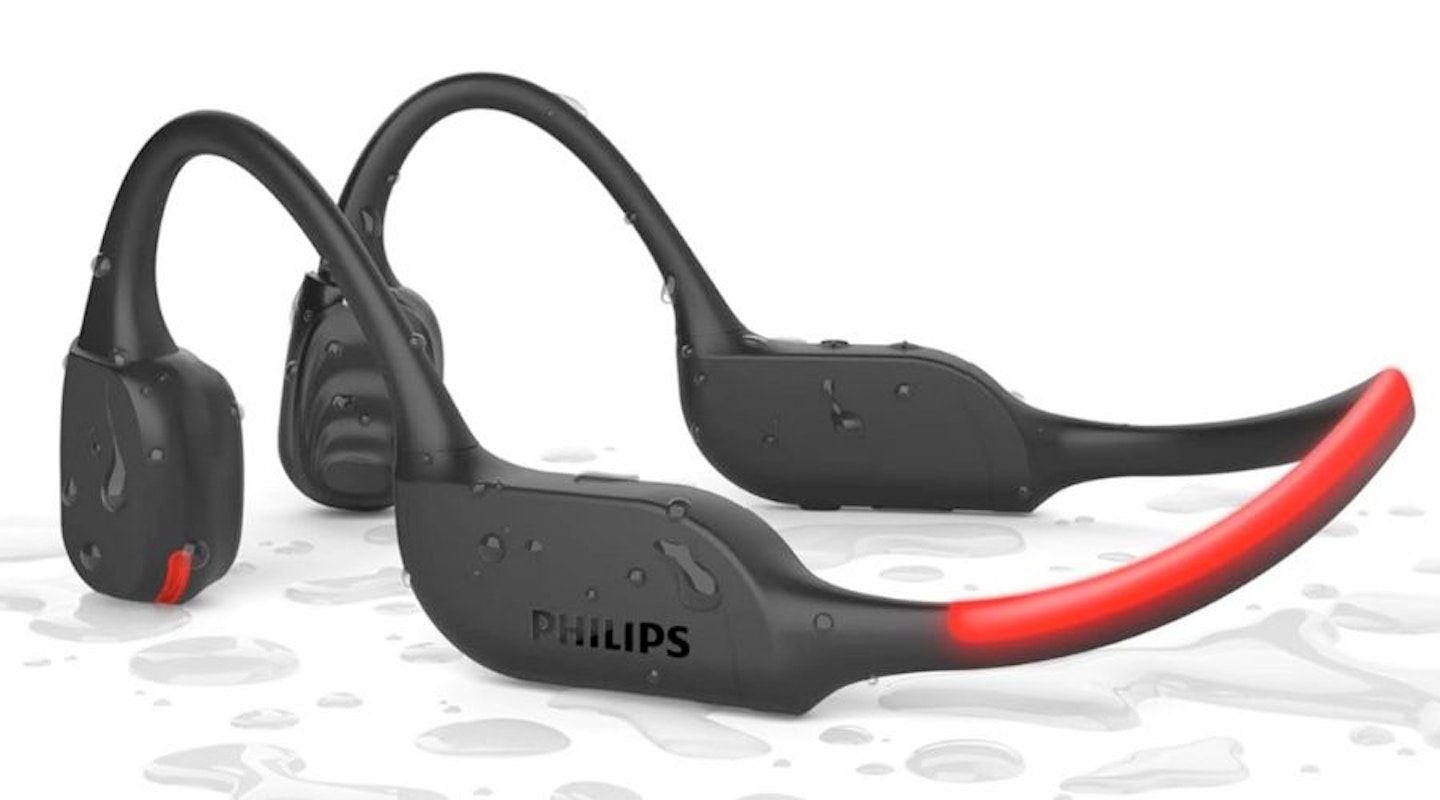
Only a few brands have been able to challenge Shokz's market share in bone-conduction headphones, but of those that have tried, Philips has made a decent run at it with the A7607. The sound quality is comparable to OpenMove's, with respectable volume and quality.
While Shokz still wins for naming conventions, the A7607s have an edge on the OpenMove in battery life, which goes up to nine hours, and IP rating, earning an IP66 classification. This makes it more adept at holding on during really heavy downpours.
A nifty safety feature included on Philips headphones is an LED strip around the head strap, which can be controlled via the app or directly from the headphones. It will reduce battery life, but it's a feature worth considering if you're exercising at night.
The shame about the Philips Audio A7607 is that its price is stuck in the middle. For your money, you are getting a quality product, but the Shokz OpenMove offers comparable specs for a far lower price. Equally, other brands offer a bump in performance for a little more.
Pros
- Solid comfortability and good sound
- Excellent safety light
- Impressive water resistance
Cons
- Fairly expensive compared to other bone-conduction headphones
| Drivers: | Bone conduction technology |
| Output power: | Not specified |
| Frequency range: | 130 Hz - 16 KHz |
| Connectivity: | Bluetooth 5.2 |
| Battery life: | Up to nine hours |
| Charging time: | Two hours |
| Waterproofing: | IP66 water-resistant |
| Dimensions: | 5.5 x 14 x 9.6 mm (H x W x D) |
| Weight: | 21 g |
Best bone-conduction headphones for swimmers and triathletes
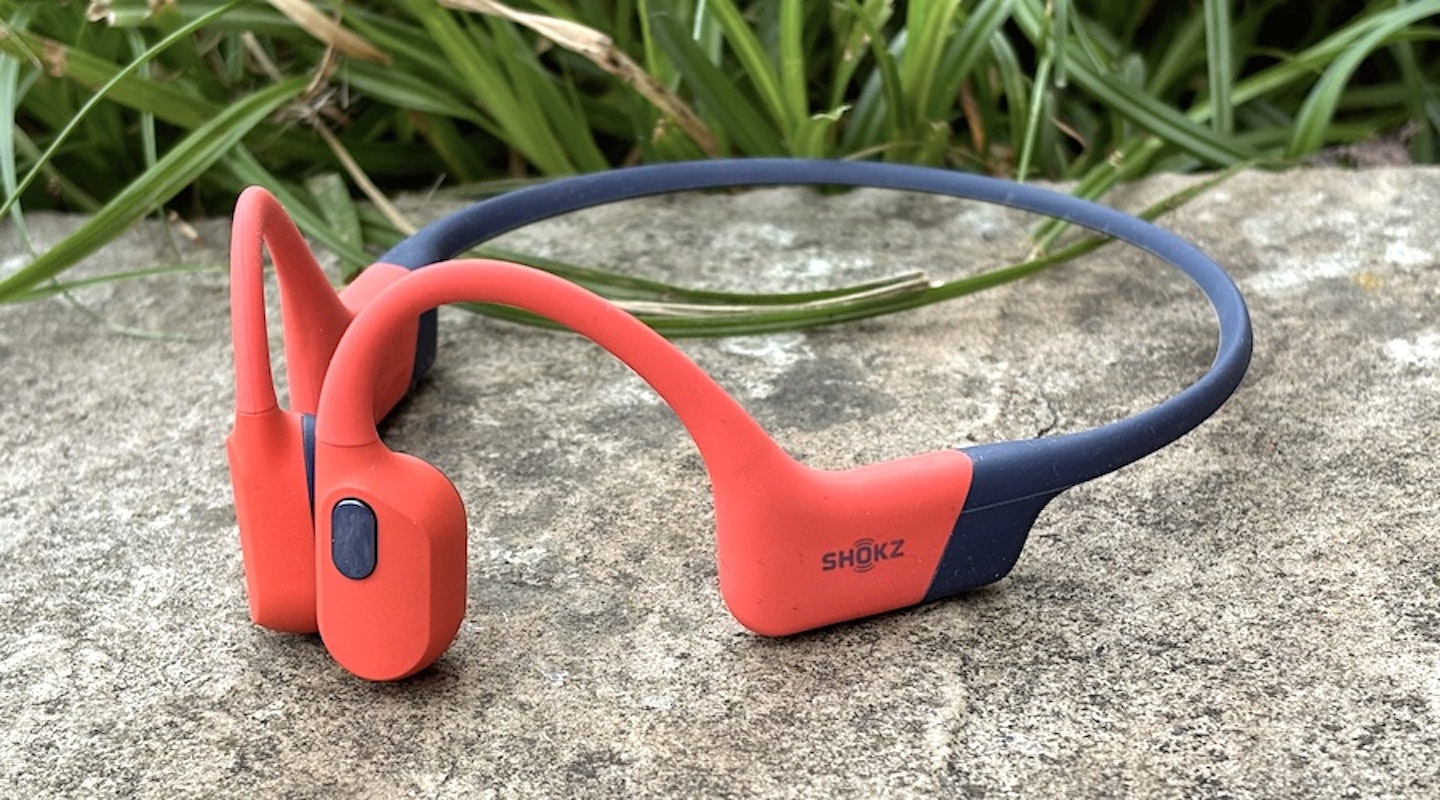 What's The Best/William Austin-Lobley
What's The Best/William Austin-Lobley With an IP68 waterproof rating and onboard music storage, the Shokz OpenSwim Pro headphones are the go-to choice for watersports, swimming and triathlons. The driver technology is the same as you will find in the OpenMove, and it's good news if you like to swim with earplugs in – because the bone-conduction technology works on vibrations that stimulate your inner ears, you can hear them without issue – in fact, you might notice a bump in bass performance.
The 32GB onboard memory can store 8,000 songs in MP3, WAV, WMA, AAC, and FLAC formats. The battery life is nine hours when listening through the Bluetooth connection and six hours when using MP3 mode.
The Shokz OpenSwim Pro were reviewed by William Austin-Lobley, who praised them:
"The OpenSwim Pro has really upped the game from the non-Pro version – which doesn't have Bluetooth. I enjoy the Bluetooth connectivity, making it feel like a better fit for running and cycling, where, being out of the water, it's easier to stream music from a phone or smartwatch. The ability to switch quickly between Bluetooth and stored music at the touch of a button is excellent news for anyone doing some back-to-back training, too."
Pros
- Quality audio performance
- Nine hours in Bluetooth mode with faster 1.5-hour quick charging
- Vastly improved MP3 storage, only 27g and fully waterproof
Cons
- Only six hours in MP3 mode, compared to eight hours in the original model
- No music organising in smartphone app
| Drivers: | 8 hours |
| Output power: | 1.5 hours |
| Frequency range: | IP68 (Waterproof) |
| Connectivity: | Internal music store only |
| Battery life: | Up to eight hours |
| Charging time: | Approximately two hours |
| Waterproofing: | IP68 |
| Dimensions: | Not specified |
| Weight: | 30 g |
Pros and cons of bone-conduction headphones
Like all devices, bone-conduction headphones offer numerous benefits but also come with some compromises. If you're considering these headphones, here are the main 'for' and 'against' to remember.
Pros
Total situational awareness: Thanks to their open-ear design and reliance on inner-ear vibration, bone-conduction headphones allow you to keep a beat on your surroundings, which is great for safety.
Light and comfortable: Bone-conducting headphones are very light, typically weighing between 20g and 30g. The over-ear hooking is unobtrusive, and though bone-conducting technology requires drivers to rest on the cheekbones, the best examples of the product rest lightly and do not dig in.
Designed for sport: Most headphones are designed for use when sitting or walking. However, bone-conduction headphones are designed with sport as the primary purpose. This means they are comfortable, stay on during vigorous activity, and have exercise-friendly features like waterproofing.
Cons
Sound quality and volume: This is probably the most significant compromise. The sound quality of bone-conduction headphones isn't as well-defined as that of headphones, with dropoff mostly impacting bass frequencies. It's still decent enough for exercise, but no one should pick bone-conduction tech if they are only looking for the best audio quality.
Battery life: Most options carry around six to 10 hours of battery, which is a little low. More advanced options offer improved listening times, but there is nothing to compete with the larger batteries on standard earphone and headphone models, such as the 100+ hourJLAB Epic Air Sport, which we've previously reviewed.
Buyer's guide to bone-conduction headphones
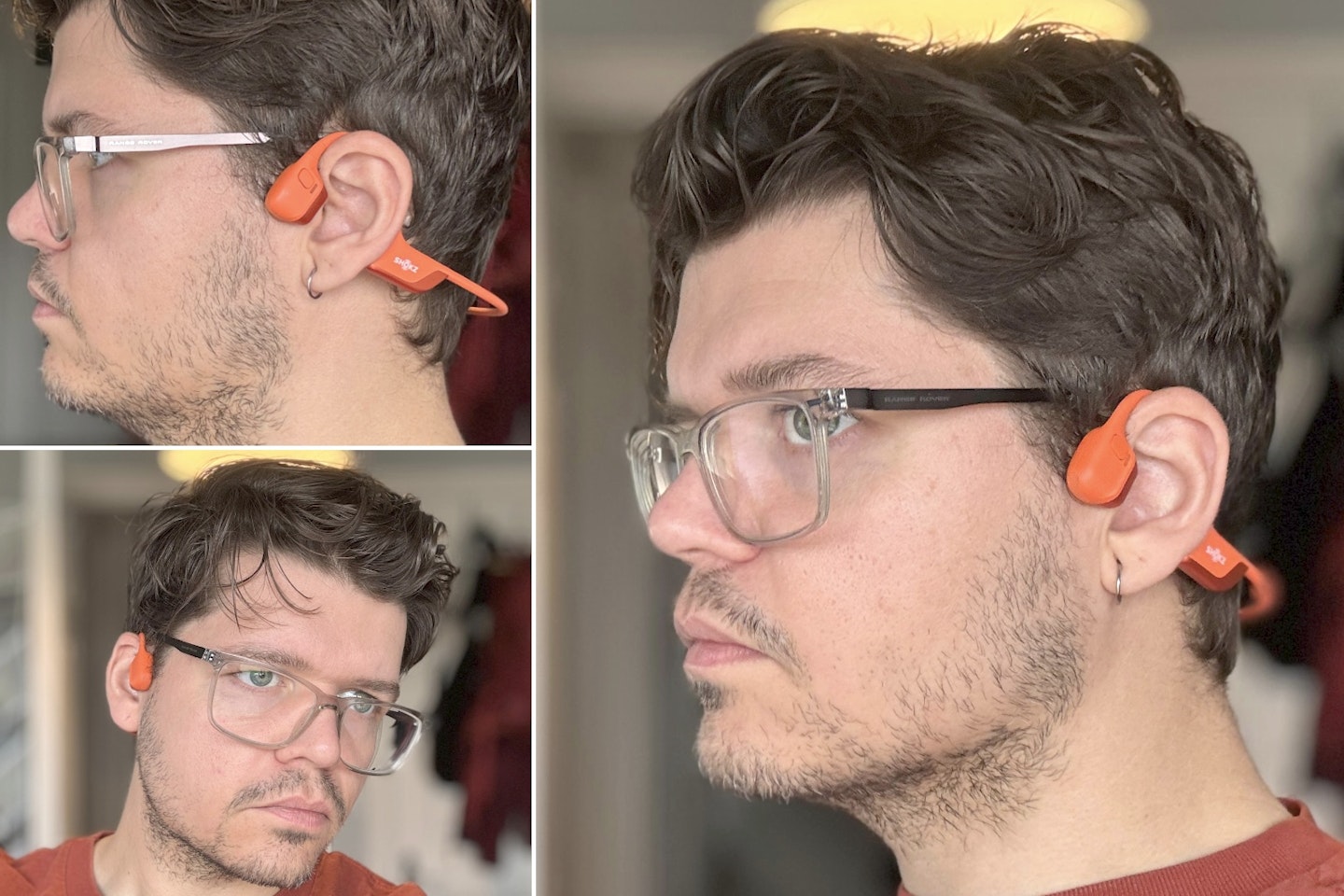
Bone-conduction headphones share many of the technologies you will find on standard headphones, but their unique transmission method also includes a few differences. For this reason, there are many features and specifications to consider when buying your new set. Below, we've explained the essential and common features of bone-conduction headphones.
Frequency Response: Typically ranges from 20 Hz to 20 kHz, similar to traditional headphones, ensuring a full sound spectrum.
Bluetooth: Most models feature Bluetooth 4.1 or higher, offering stable and quick wireless connectivity up to a range of 10 meters. Some advanced models support connecting multiple devices simultaneously, making it easy to switch between devices such as a phone, smartwatch, or laptop.
Battery Life: The average battery life ranges from six to 10 hours of continuous use, depending on volume levels and features. This is shorter than traditional headphones and earphones, but it will still be fine for most short-, mid-, and long-distance exercises. They typically take around 1.5 to 2 hours to charge fully via USB-C or proprietary magnetic charging cables.
Weight: Lightweight designs, usually between 30g and 50g, to ensure comfort during prolonged use.
Material: Made from durable, sweat-resistant materials such as titanium and silicone, ensuring both longevity and comfort.
IP Rating: IP55 or higher offers protection against sweat, rain, and dust, making them suitable for various weather conditions and intense workouts.
On-Device Controls: Easy-to-access buttons for play/pause, volume adjustment, and call management.
Voice Assistants: Compatibility with voice assistants like Siri and Google Assistant for hands-free control.
Microphone: Built-in noise-cancelling microphones for clear calls and voice commands.
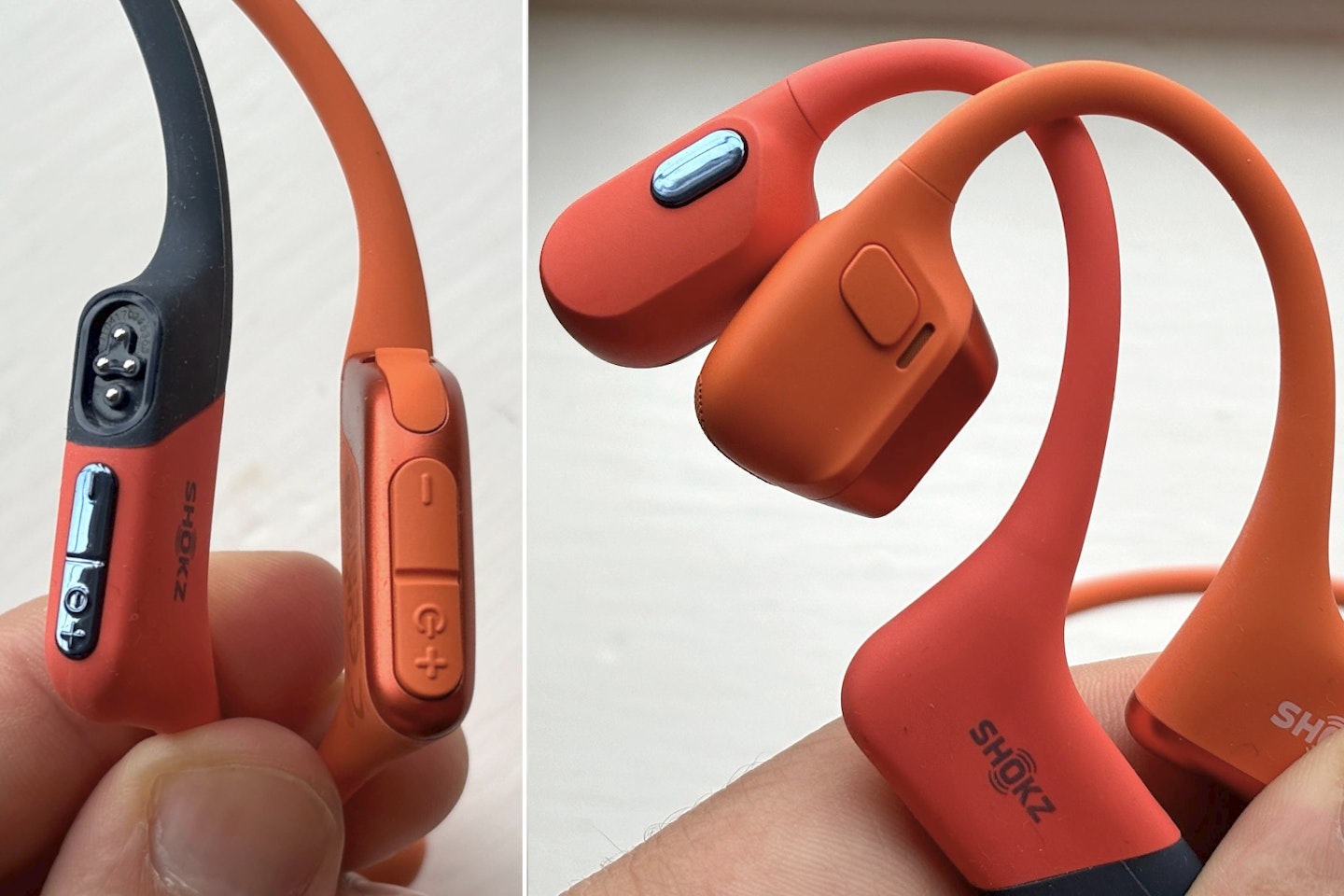
<strong>FAQ: Your questions answered</strong>
What are bone-conduction headphones?
Bone-conduction headphones allow you to listen to personal audio while keeping your ear open, which helps maintain situational awareness.
How do bone-conduction headphones work?
Bone-conduction headphones have transducers that rest on your cheekbones. When audio plays, these transducers create vibrations that travel through the bones in your skull. These vibrations bypass the eardrum and reach the cochlea in the inner ear. Your brain takes it from there, processing the vibrations as sound. While the vibrations are processed as sound that the user can hear, the ear canal and eardrum remain free and open to ambient sound. In short, your 'traditional' hearing is unhindered.
This information was informed by ablog post from Shokz, the leading brand in bone-conduction headphone technology.
What makes bone-conduction headphones so good?
Environmental awareness: Bone-conduction headphones allow users to remain aware of their surroundings by keeping the ear open. This is ideal for safety when listening to audio outdoors or in potentially hazardous environments.
Fit and comfort: Bone-conduction headphones are lightweight and have a band that fits securely around the head without applying pressure on the ears. This makes them ideal for extended use during workouts or daily activities.
Race-approved: Many sporting events approve using bone conduction headphones because they do not block external sounds, ensuring participants can hear essential announcements or warnings during races.
Cleanliness: Unlike in-ear headphones, bone conduction models do not enter the ear canal, reducing the risk of ear infections and bacteria buildup. This makes them a more hygienic option, especially for athletes who sweat during their activities.
Are there alternatives to bone-conduction headphones?
Yes and no. Many earphones and headphones carry "hear-through" modes, which use microphones to play outside sounds along with your audio. While this is okay in some situations, we have found that the experience doesn't feel as authentic or vital as true open-ear listening, leaving you less alert and aware of potential dangers.
Alternatively, a rival bone-conducting technology is emerging called air-conduction, which sits away from the ear and plays music into the ear from a slight distance. We reviewed a pair, the OneOdio OpenRock Pro, in a group test of hook earphones, though again, we preferred the bone-conduction experience.
The flat "no" answer is that some events do not recognise "hear-through" modes and air-conduction options as safe, and thus, you may have trouble if you rely on music to get you through your official events.
Are bone-conduction headphones better for your ears?
HearingHealthMatters.org claims that "because the bone conduction headset does not cut the user off from the environment, it is considered safer than air conduction alternatives. Additionally, there is no damage from stimulus intensity and/or the constant ear insertion earbuds and other types of insert headphones".
Can bone-conduction headphones damage hearing?
We've established that headphones don't block out ambient noises when you're out running and that you can hear what is going on around you. But, does this mean you are all-clear from hearing damage?
When it comes to hearing, prolonged listening through any personal devices at unsafe volumes can cause permanent damage. So make sure you listen to that podcast, radio station or playlist at a safe volume.
According to the NHS website, any noise level louder than 85dB (decibels) can be harmful, and to put that in perspective, listening to music on full volume through headphones can reach 100 to 110 dB.
How to wear bone conduction headphones correctly?
Is this your first time wearing bone-conduction headphones? Here's a step-by-step guide to ensure you put this device on correctly.
Step one: Put the curved section of the headphone over your ear so that it sits on your outer ear.
Step two: Make sure that it's loose and not tight to your head.
Step three: Always (and we mean always) read the instructions from your manufacturer to ensure you've completed all the right steps.
Can you wear bone-conduction headphones with glasses?
Specific frames, the size of your head and its shape may affect how comfortable it feels, but they shouldn't stop you from wearing them.
If you're struggling to find the perfect fit, we'd recommend moving the bone conduction headphones over or under your frames for a different type of pressure.
How we chose these products
Our selection process focuses on user feedback, pricing, and versatility for different needs. We carefully assess each product's specifications to ensure they meet users' requirements without additional costs. Our team also considers first-hand product experiences, whether through personal use or comprehensive reviews. We choose retailers based on their pricing, product availability and delivery reputation.
William Austin-Lobley is the Editor for What's The Best. Here, he oversees, curates and researches listicles and reviews as many products as his home office can handle.
He has spent nearly five years writing about tech, audio, outdoors and fitness and has reviewed everything from smartphones to ice baths. In addition, he's well-versed in sniffing out the best deals and savings the internet offers.
When not at his desk writing, reviewing or deal-hunting, he'll be relaxing with Japanese crime novels, bingeing some classic anime, strolling the countryside or at the gym listening to the heaviest metal Spotify has to offer.
Subscribe to the What’s The Best Newsletter to keep up to date with more of the latest reviews and recommendations from the What’s The Best team.
